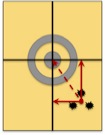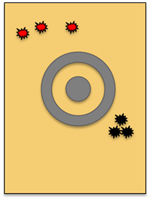Zero Considerations
There are many different thoughts on what a good Battle Sight Zero (BZO) distance should be. One truth will hold against all arguments. Know your zero distances and holds. Once you have become comfortable with a given zero, stay with it. This may seem obvious but it often gets lost in new opinions.

Yards & Meters
MOA per Click for:
Iron Sights
B/U Sights
Many Optics
Downloadable Sheets!!
Which zero distance is the most effective?
The analysis below is very general. There are so many configurations, sights, barrel lengths, rates of twist and ammunition types out there that it is almost impossible to talk about specifics. For the sake of simplicity let's use a 1 1/2" sight elevation, 16" barrel and a 62 grain bullet.
The numbers below are derived from the Winchester Ballistics Calculator for iPhone. The graphics are for illustration only and not to scale.

The standard 25 yard zero has a, relatively, high apex at about 3 inches. This apex is somewhere around 180 yards. It re-crosses the zero line between 250 and 300 yards. Then drops quickly after that.

A 50 yard zero has a flatter trajectory, around an inch at the apex (120ish yards) a second zero around 180 yards. This zero distance is a full 10 inches low at 300 yards then drops off.

The 100 yard zero is a very flat trajectory. It holds an average one-inch deviation along the Line of Sight until 180 yards where the drop really starts. At 300 yards it is 12 inches low.
So, what do you want?
A flatter trajectory with shorter range?
A more drastic arc and greater range?
How far do you want/need to shoot?
Your zero is an average of:
the inherent accuracy of your rifle,
the precision of your sights
your shooting habits and physiology.
If you have good shooting habits and can consistently shoot a 1 inch group, your shot should be somewhere within a half inch of your point of aim, in semi-perfect conditions.
group, your shot should be somewhere within a half inch of your point of aim, in semi-perfect conditions.
The black shot group is easy to work with, how do you evaluate the red group?
If you can't hold a 2 inch group at 25 m/yd, and this sounds harsh, don't even bother to zero until you can shoot a tighter group. The ability to zero is completely dependent on consistency. If you are inconsistent, you will chase holes all over the target, become frustrated and waste a lot of time adjusting sights back and forth.
Check your sights(optics), are they mounted correctly?
And/or get a coach or friend to help you diagnose your shooting problem.
The analysis below is very general. There are so many configurations, sights, barrel lengths, rates of twist and ammunition types out there that it is almost impossible to talk about specifics. For the sake of simplicity let's use a 1 1/2" sight elevation, 16" barrel and a 62 grain bullet.
The numbers below are derived from the Winchester Ballistics Calculator for iPhone. The graphics are for illustration only and not to scale.

The standard 25 yard zero has a, relatively, high apex at about 3 inches. This apex is somewhere around 180 yards. It re-crosses the zero line between 250 and 300 yards. Then drops quickly after that.

A 50 yard zero has a flatter trajectory, around an inch at the apex (120ish yards) a second zero around 180 yards. This zero distance is a full 10 inches low at 300 yards then drops off.

The 100 yard zero is a very flat trajectory. It holds an average one-inch deviation along the Line of Sight until 180 yards where the drop really starts. At 300 yards it is 12 inches low.
So, what do you want?
A flatter trajectory with shorter range?
A more drastic arc and greater range?
How far do you want/need to shoot?
Your zero is an average of:
the inherent accuracy of your rifle,
the precision of your sights
your shooting habits and physiology.
If you have good shooting habits and can consistently shoot a 1 inch

The black shot group is easy to work with, how do you evaluate the red group?
If you can't hold a 2 inch group at 25 m/yd, and this sounds harsh, don't even bother to zero until you can shoot a tighter group. The ability to zero is completely dependent on consistency. If you are inconsistent, you will chase holes all over the target, become frustrated and waste a lot of time adjusting sights back and forth.
Check your sights(optics), are they mounted correctly?
And/or get a coach or friend to help you diagnose your shooting problem.
Click here to go to the Zero Procedure page.
or
Follow the links below for adjustment information from these manufacturers.
EOTECH
AIM POINT
Bushnell
C-MORE
Leopold
Trijicon
GG&G BUIS
MOA Calculator








